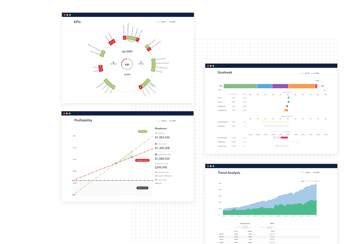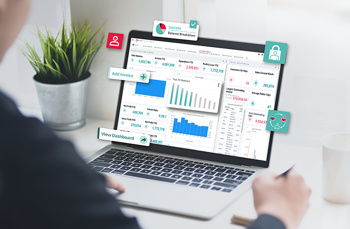10 ways to improve cash flow
Every business obviously needs to have more cash flowing in rather than out of it in order to stay afloat, pay staff and bills, and hopefully make a profit. But cash flow can fluctuate and it’s important to know a range of ways to improve cash flow rather than simply relying on revenue growth. It’s not always possible to instantly sell more – but there are other methods of improving cash flow that you can adopt to help alleviate the situation quickly.
This article covers the impact cash flow problems can have on your business, how to avoid cash flow problems and 10 ways to improve your cash flow.
The impact cash flow problems can have
It’s an unfortunate fact of life that cash flow problems can be one of the earliest signs of business failure. That’s why it’s so vital to understand how to solve cash flow problems quickly, and before the situation gets out of hand. A negative cash flow can impact a business in a variety of ways.
Slow growth
If you’re not meeting your sales forecasts, it soon becomes impossible to also achieve longer term growth targets. You will also see a knock-on effect on other pipeline plans to support growth such as scaling up on staff, updating systems, or upgrading premises for example. Cash flow problems need to be dealt with quickly to avoid derailing longer term plans.
Stretching out your payment terms
Delaying paying your suppliers might feel like a short term fix but in reality, it can damage your business relationships and create a snowball effect. Not paying your suppliers on time will very quickly damage your business reputation and potentially damage your brand too.
Not being able to pay staff on time
If negative or poor cash flow becomes more sustained, it becomes increasingly difficult to access the money required to pay your staff. Payroll is often one of the largest regular outgoings for many businesses. Not paying your people on time will soon destroy worker loyalty and damage morale.
Late debt payments or defaults
Another problematic issue is maintaining regular payments for loans. This can exacerbate the cash flow problem when you add in interest charges and start racking up additional fees as a result of late payments. Eventually this will also impact your business credit rating, which in turn affects your ability to borrow in the future. It also takes a while to repair, even when cash flow has returned to positive.
Legal action
Where negative cash flow results in unhappy creditors who are unable or unwilling to wait for the money they are owed, you may also face legal action as some will actively pursue other ways to recover their cash.

How to avoid cash flow problems
Before we dive into how to tackle poor cash flow, below are some examples of how to avoid cash flow problems arising in the first place. Take time first and check if your business is already mitigating the risk of negative cash flow with all of the following action points.
Don’t automatically expect to make a profit
Enthusiasm is a wonderful thing but don’t be one of those over-confident start-ups that assumes that by simply opening their new premises or launching a new website that customers will automatically arrive. When you’ve already spent cash on getting to that point, bear in mind that it might take some time to start reaping those rewards.
Create the right budget
Ensure you are realistic and accurate with your cash flow budget. Consider how much cash is expected to come in and when (not every customer will pay on time) and align that with what you expect to pay out over a given period. Your bills or staff shouldn’t be paid late – however some of your customers may feel that it’s fine to decide their own payment terms rather than meet yours.
Look at past payment performance for your regular customers
When you’re pulling together your cash flow plan, you can dig a little deeper and assess when specific customers are most likely to pay but looking at what’s gone before. Unfortunately some customers will think it’s acceptable to pay all their suppliers weeks (or even months) after a product or service has been provided – and do so as a matter of course. You can plan for this. You can also introduce ‘incentives’ to pay on time such as early payment discounts, or disincentives such as late payment fees, to try and address the issue with serial offenders.
Consider overhead costs and look for possible savings
It’s great to have the best equipment and the nicest work environment, but sometimes it’s necessary to rein in spending whilst you’re trying to manage cash flow tightly. Have you examined all the possible options to keep overheads to a manageable level? And are there some expenses that could be delayed or reduced?
Focus on accounts receivable
A sale can’t truly be counted as a sale until you’ve been paid – so do make sure that you have good procedures in place. From invoicing quickly to setting clear terms and chasing up late payers, staying on top of your accounts receivable activity is a proven way to ensure you don’t simply drift into choppy waters on the back of customers who are not paying on time. Lots of sales being agreed in principle don’t always result in good cash flow.
Give yourself enough of a cushion
If you run your cash flow budget too tightly, you might find problems occur when the unexpected happens such as a customer defaulting unexpectedly on their payment or even going out of business whilst still owing you money. Things do go wrong sometimes, so have a potential fall-back fund so that their issues don’t create problems for you.
Don’t over-order
It’s tempting to bulk order supplies, raw materials, packaging etc. on the basis that you’ll use it anyway. But tying up money in your inventory is a common way to cause cash flow problems. If you don’t get through it as quickly as expected, it’s usually impossible to convert unused stock back into cash without losing money in the process. Buyer beware!

How to solve cash flow problems
There’s no shame in having cash flow problems from time to time. Let’s not forget that the world of business is an uncertain one with no guarantees. To get your business back on track, and avoid the issues that negative cash flows can cause, check out these 10 ways to solve cash flow problems.
10 ways to improve cash flow
- Actively encourage customers to pay on time
Although it’s certainly common (and simpler) to offer every customer the same terms, you could be missing a trick. Differential pricing, early payment bonuses and late payment penalties are all proven methods for improving cash flow. You might need to ensure your accounts payable systems can support the process effectively, but in the long run you should see some improvements.
- Look for staff cost savings
When payroll is such a large part of any business outgoings, it’s also a good place to look for potential savings. Consider whether some staff might want to go part-time for example. What does your temporary staff bill look like – and could you make savings by taking on employees rather than paying for expensive temps? Even encouraging more to work from home can have a knock-on effect on heating, lighting and space rental costs for example.
- Manage your stock and suppliers
‘Just in time’ (JIT) processes for managing stock are well established in the manufacturing industry and offer food for thought for other sectors to consider too. One of the key elements of efficient JIT management is having a good system in place to ensure that the inventory is always tightly managed in real time so you never have too much or too little to meet your needs. That usually means decent stock management technology. At the other end of the spectrum, you might find it’s worth just auditing your stock regularly and talking to your suppliers to see if you can spread out orders into smaller deliveries – and thus spread out your payments into smaller chunks over a time period to help improve your cash flow.
- Consider the impact of new assets and investments
If you’re on a growth pathway with a detailed business plan, you might have capital expenditure or investment looming. Before committing to any new expenditure, make sure your cash flow forecast and cash cushion are robust enough to manage if circumstances change. There’s not point in sticking to the business plan if the stretch subsequently puts your stability at risk.
- Check your accounts payable terms
Do you offer standard 15 days or 30 days payment terms for your customers? How does this compare with others in your sector? It’s worth taking some time to assess if your accounts payable terms and procedures are still in step with your industry. Your competitors might for example be taking part payment up front and the balance on completion (which of course is great for cash flow). Or you might be the only one left offering generous payment terms and find that others are expecting and receiving their payments in less time that you are used to. If there’s no incentive to pay you quickly, why would your customer bother to?
- Cut unnecessary spending
It might sound obvious but as one of the ways to improve business cash flow, this is one of the most effective ways to make a difference quickly. Ask your managers across the business to find savings in their departments. Some companies find that asking employees for their ideas is a good way to discover new savings that haven’t been thought of before. Cost-cutting doesn’t always have to be a negative – sometimes it can be a way to recognise individuals for their innovative ideas.
- Consider leasing instead of buying
As well as being tax deductible, leasing the vehicles and equipment you need to run your business can also be quite a lot cheaper than buying outright. An additional benefit is that you can then replace with newer kit after a set period too.
- Make it easier for customers to pay you
The days are long gone when business customers sent a cheque in the post. Now there are such a huge variety of ways to pay for goods and services from BACS payments to contactless, digital currency, mobile payments, and third party payment platforms. So consider how easy it is for your customers to pay you. You can even ask your customer base what payment methods they would like to see to make their lives easier too.
- Consider invoice factoring
Many businesses use invoice factoring as a means of accessing cash to alleviate temporary cash flow issues. An invoice factoring business will ‘buy’ your outstanding invoices from you for a proportion of their value, thus providing you with cash. They then collect those payments on your behalf within a set time period. The balance collected is then paid to you, minus the fee for the factoring company.
- Maintain a cash flow forecast
Staying on top of your cash flow means keeping right up to date on the detail. Your cash flow forecast should provide the information you need to see clearly what your cash flow position is and how it spans the next 12 months. Read on to find out how to improve your cash flow forecast.
How to improve cash flow forecast
Measuring the flow of cash going into your business (from sales, investors etc) as well as out of your business (to pay staff, suppliers, buy stock etc) is the data that constitutes a cash flow forecast.
What can make a difference however, is how much detail and how accurate your cash flow forecast is. Improving your cash flow forecast and ensuring it is kept completely up to date will benefit your business in multiple ways.
- Provide greater insight to support business decisions
- Build stakeholder confidence that cash flow is robust
- Show early signs of potential issues
One proven way to improve cash flow forecasting is to use software to crunch your numbers. There are lots of cash flow forecasting solutions available so it’s important to consider the size and complexity of your business before choosing your provider.
Comprehensive finance software packages such as Access Financials include cash flow forecasting functionality along with the full range of finance tools. Many medium-sized companies use this to improve their business cash flow thanks to the key insight it provides.
Further reading: How to do a cash flow forecast.
Improving cash flow with a cash flow forecasting system
As we’ve seen, the key to improving cash flow is having complete transparency across your business data, and ensuring your cash flow forecast is accurate and up to date.
Our cash flow forecasting software brings together powerful reporting, fast cash flow forecasting and actionable financial insights into one solution. You'll be able to predict your future cash flow easily, allowing you to keep ahead of your business' performance and make great decisions for the future.
To see the cash flow forecasting software in action, book a demo so our finance specialists can show you all the great features.

Want to learn more?
Find out more cash flow and accounting information, guidance and advice.

How to do a cash flow forecast?
How to do a cash flow forecast
Best Cash Flow Forecasting Software
Best cash flow forecasting software
How to choose the right accounting software
How to choose the right accounting software
How much does accounting software cost?
Accounting software cost
How to implement a new accounting system
How to implement a new accounting system

 UK
UK
 SG
SG
 MY
MY
 US
US
 IE
IE